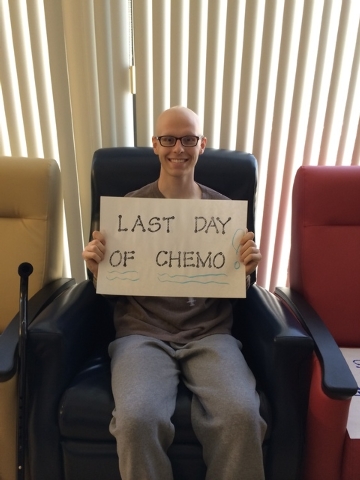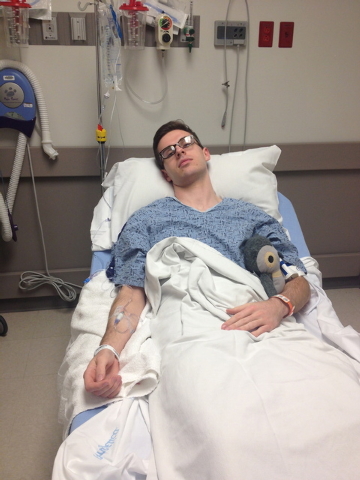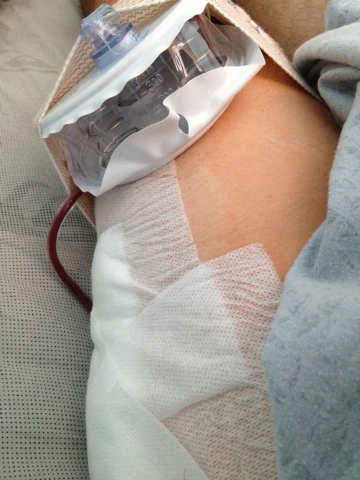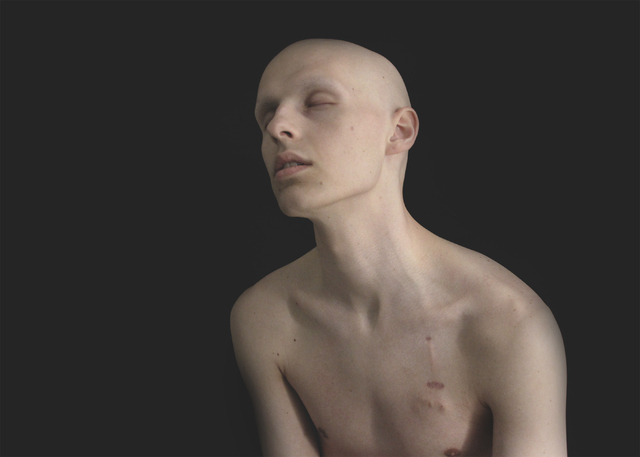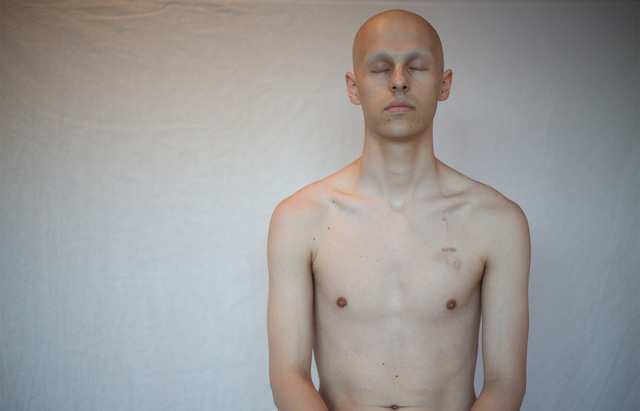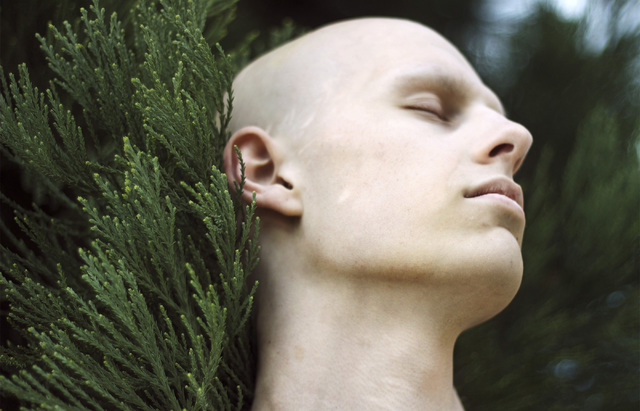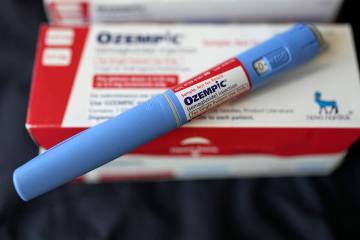Teen shows reality of cancer through Instagram
At first glance, Michael Tatalovich’s Instagram page looks similar to those of other teens: a collage of selfies snapped at parties and goofy poses with friends, along with a few artsy landscapes added for good measure.
Scroll more closely through the hundreds of images, however, and you’ll also see a photo of the Coronado High School alum propped up in a hospital bed with tubes snaked around his arm.
Another offers a painfully close view of the long, stapled incision where doctors removed the top half of his left femur and partially replaced his hip.
Tatalovich posted the latter photos on his page (instagram.com/mtat95) in the spring of 2013, when at age 17 he was diagnosed with Ewing sarcoma, a rare soft-tissue and bone tumor that typically strikes adolescents.
About 200 cases of Ewing sarcoma are diagnosed each year in the United States. The cancer, which can develop anywhere in the body, most commonly affects the arms, legs, ribs, spinal column and pelvis.
A cancer diagnosis was the last thing Henderson native Tatalovich ever expected to receive.
He’s a longtime volleyball player, and was on Coronado’s team during his sophomore and junior years. As an amateur photographer, he took sports photos that were featured in the school’s yearbook.
In June 2012 he said he noticed some “abnormality” in his left hip, prompting him to see a local orthopedic surgeon who conducted several noninvasive tests.
The doctor determined the teen probably bruised his femur while playing sports, and ordered Tatalovich to take it easy for a few months to allow the bone time to heal with the help of physical therapy.
By that fall, the painful symptoms had subsided and he returned to playing volleyball. “We thought it had been cured,” he recalled.
In January 2013, however, Tatalovich again began experiencing pain along with difficulty walking. With his parents, he turned to other local doctors in search of a second opinion, including an endocrinologist who suggested the teen may have been suffering from Paget’s disease, a degenerative bone condition that usually is seen in middle-age people.
“It was kind of a weird diagnosis,” he said.
That spring, while participating in an outdoor photo shoot, Tatalovich said an insect unexpectedly flew past him. In his recoil from the bug, he swung his left leg sideways — a quick motion that “basically broke the neck of my femur.”
He was transported to St. Rose Dominican Hospital’s Siena Campus and underwent several days of testing.
That’s also when he began posting photos about the experience on his Instagram page, which boasted about 800 followers, mostly friends from school and others he knew throughout the Las Vegas Valley.
Given his affinity for photography, “I had always kind of gravitated towards Instagram as my social media of choice,” he explained. “People had seen (online) that I was in the hospital and they were wondering what was going on, and I wanted to let them know what was happening, and I thought one of the best ways to do that is post a picture and a caption that explains everything.”
Tatalovich underwent a bone biopsy on May 1, 2013, which revealed the stage 1 Ewing sarcoma tumor in his leg.
The diagnosis, he recalled, “almost didn’t register with me … but at the same time, there were tears streaming down my face and my parents’ faces.”
Later that day, he posted on Instagram a photo of a pump that had been installed to drain excess fluid from his leg along with a caption explaining his cancer diagnosis:
“I may not be my normal self over the next couple months,” he wrote, “but just know it’s because I will be fighting this and trying to make the best of everything.”
Tatalovich soon began an 11-week course of chemotherapy. He continued to post photos in the months that followed, even after the powerful medication dramatically altered his appearance.
“Once I had lost my hair and kind of was looking sicker already from the chemo, that’s when I said, ‘Hey, I don’t want this (disease) to control me. I don’t want to be embarrassed by what’s going on. I want to be empowered through it,’ and I used Instagram for this.”
Some of the most gripping photos on his page are portraits (snapped by a fellow photographer) of the shirtless teen looking pale and fragile. At first, he said, his mother tried to discourage him from posting the pictures.
“She said, ‘Oh my gosh, Michael, you cannot post that because you look so sick. People are going to be terrified that you are literally dying,’ and I was like, ‘Mom, this is what I look like. … There’s no Photoshopping going on here, there’s no theatrics at work. … If I look really sick it’s because I look really sick.’ ”
Sharing photos online helped Tatalovich “remain creative in whatever way I could during that time,” which proved “pretty important for my spirit,” he said.
It also caused his number of Instagram followers to grow to nearly 24,000 as people worldwide learned of his plight (his story has been featured on several websites, including that of NBC’s “Today” show).
He doesn’t consider himself an inspiration, although others do.
“I had to go through chemo and be strong and to see this through to the end, so I guess you could see how people could see that (as inspirational), but I don’t see that,” he said. “I had always taken pictures and I had always been a really open person, so … there wasn’t even a thought that crossed my mind that I wouldn’t share those (photos).”
Dr. Alexandra Walsh, Tatalovich’s physician at Children’s Specialty Center of Nevada in Las Vegas, only recently learned about her patient’s Instagram page. But she said she isn’t surprised that he turned to social media to document his experience.
“I thought the pictures were wonderful,” she said. “I saw him (at the) clinic and in the hospital through all of this, and it was interesting seeing the reality” of the disease through his photos.
Although some teens can be really private about sharing the news of a cancer diagnosis, Walsh said, “Michael isn’t. He’s open and he’s out there. He’s not shy. And I’m sure having that support from people all over the country really meant a lot to him.”
Following his partial-hip-replacement surgery in the summer of 2013, Tatalovich spent months at home recovering while confined to a wheelchair and undergoing 26 more weeks of chemotherapy.
He was absent from school for most of the first half of his senior year at Coronado, dashing his hopes of graduating with valedictory honors. All the while, he continued to receive well wishes via Instagram from his classmates, who voted him homecoming king that fall.
In March, Tatalovich posted a photo of himself holding a sign heralding his final chemotherapy treatment.
“I can’t wait to make this just a part of my story and no longer a defining characteristic,” he wrote in the caption.
His long-term prognosis is “pretty good,” said Walsh, because the cancer was caught relatively early and did not spread to other parts of his body. His biggest health hurdle going forward, she said, may be coping with the lifelong mobility restrictions often faced by bone-tumor patients.
Although he is fully recovered physically and can walk unassisted, 19-year-old Tatalovich will never again run or jump as a result of the partial hip replacement. His days of playing volleyball competitively are over.
He has, however, participated in pickup games with fellow students at the University of Texas, Austin, where he recently began studying chemistry.
“It wasn’t supercompetitive or superserious, so that was like the perfect environment for me,” he said of the matches.
Tatalovich continues to post frequently on Instagram, although his more recent offerings — quirky diner interiors, interesting architectural images and such — are a marked departure from many of last year’s frames, which he calls “a great reflection tool to see where I was and how I was feeling at the time and what I looked like at the time.”
Most days, however, “I don’t even think about the cancer coming back,” he said, “because I know that no matter what, I’m still going to charge on with my life.”




